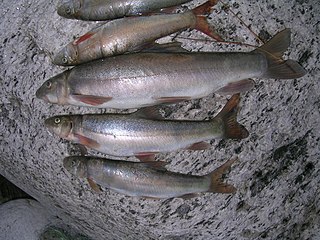
The Indian pond heron or paddybird is a small heron. It is of Old World origins, breeding in southern Iran and east to the Indian subcontinent, Burma, and Sri Lanka. They are widespread and common but can be easily missed when they stalk prey at the edge of small water-bodies or even when they roost close to human habitations.
Opisthorchis viverrini, common name Southeast Asian liver fluke, is a food-borne trematode parasite from the family Opisthorchiidae that infects the bile duct. People are infected after eating raw or undercooked fish. Infection with the parasite is called opisthorchiasis. O. viverrini infection also increases the risk of cholangiocarcinoma, a cancer of the bile ducts.
Galactosomum is a genus of flukes in the family Heterophyidae. There are currently 28 recognised species within the genus. They mainly infect aquatic birds, but often infest fish as larvae. Three species are known to use marine mammals as hosts.

The red-rimmed melania, also known as Malayan livebearing snails or Malayan/Malaysian trumpet snails by aquarists, is a species of freshwater snail with an operculum, a parthenogenetic, aquatic gastropod mollusk in the family Thiaridae.

Schizothorax is a genus of cyprinid fish found in southern and western China, through northern South Asia (Himalaya) and Central Asia, to Iran, with a single species, S. prophylax, in Turkey. They are primarily found in highland rivers, streams and lakes, although a few species occur in lower-lying locations, like Lake Balkhash and lakes of the Sistan Basin. Their scientific name means "cloven-breast", from Ancient Greek schízeïn (σχίζειν) 'to cleave' and thórax (θώραξ) 'breast-plate'. The western species are typically referred to as marinkas from their Russian name marinka (маринка), while the eastern species are usually called snowtrout. Although they do resemble trouts in habitus this is merely due to convergent evolution and they are by no means closely related apart from both being Teleostei: Cyprinids are in the teleost superorder Ostariophysi, while trouts are in the superorder Protacanthopterygii. Their ancestors must thus have diverged as early as the Triassic, more than 200 million years ago.

Radix rubiginosa is a species of air-breathing freshwater snail, an aquatic pulmonate gastropod in the family Lymnaeidae, the pond snails.

Heterophyidae is a family of intestinal trematodes in the order Plagiorchiida.

Haplorchis taichui is a species of intestinal fluke in the family Heterophyidae. It is a human parasite.

Opecoelidae is a family of trematodes. It is the largest digenean family with over 90 genera and nearly 900 species, almost solely found in marine and freshwater teleost fishes. It was considered by Bray et al. to belong in the superfamily Opecoeloidea Ozaki, 1925 or the Brachycladioidea Odhner, 1905.

The Diplectanidae are a family of monopisthocotylean monogeneans. They are all parasitic on the gills of fish. Diplectanids are small animals, generally around 1 mm in length. As parasites, they can be extremely numerous, up to several thousand on an individual fish.

Semisulcospira libertina is a species of freshwater snail with an operculum, an aquatic gastropod mollusk in the family Semisulcospiridae. Widespread in east Asia, it lives in China, Taiwan, Korea, Japan, and the Philippines. In some countries it is harvested as a food source. It is medically important as a vector of clonorchiasis, paragonimiasis, metagonimiasis and others.

Metagonimus yokogawai, or the Yokogawa fluke, is a species of a trematode, or fluke worm, in the family Heterophyidae.
Metagonimus miyatai is a species of a trematode, or fluke worm, in the family Heterophyidae.
Heterophyes nocens is a species of trematodes, or fluke worms, in the family Heterophyidae.

Heterophyes is a genus of trematodes, or fluke worms, in the family Heterophyidae.

Helicometra is a genus of trematodes in the class Opecoelidae. It is synonymous with AllostenoperaBaeva, 1968, MetahelicometraYamaguti, 1971, and StenoperaManter, 1933. Its type species is H. fasciata(Rudolphi, 1819). They are distinguished by their unique spiral uterus, from which their name is derived.
Tellervotrema is a genus of trematodes in the family Opecoelidae.
Hexagrammia is a genus of trematodes in the family Opecoelidae.

Carmen Camacho Velasquez was a Filipino parasitologist. She specialized in parasites of the tropical fish of the Philippines. She is known for her work on the taxonomy of Digenea and was the first to describe the parasitic nematode Capillaria philippinensis, which causes intestinal capillariasis in humans.











